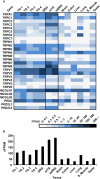RNA-Seq Analysis of Human Trigeminal and Dorsal Root Ganglia with a Focus on Chemoreceptors
- PMID: 26070209
- PMCID: PMC4466559
- DOI: 10.1371/journal.pone.0128951
RNA-Seq Analysis of Human Trigeminal and Dorsal Root Ganglia with a Focus on Chemoreceptors
Abstract
The chemosensory capacity of the somatosensory system relies on the appropriate expression of chemoreceptors, which detect chemical stimuli and transduce sensory information into cellular signals. Knowledge of the complete repertoire of the chemoreceptors expressed in human sensory ganglia is lacking. This study employed the next-generation sequencing technique (RNA-Seq) to conduct the first expression analysis of human trigeminal ganglia (TG) and dorsal root ganglia (DRG). We analyzed the data with a focus on G-protein coupled receptors (GPCRs) and ion channels, which are (potentially) involved in chemosensation by somatosensory neurons in the human TG and DRG. For years, transient receptor potential (TRP) channels have been considered the main group of receptors for chemosensation in the trigeminal system. Interestingly, we could show that sensory ganglia also express a panel of different olfactory receptors (ORs) with putative chemosensory function. To characterize OR expression in more detail, we performed microarray, semi-quantitative RT-PCR experiments, and immunohistochemical staining. Additionally, we analyzed the expression data to identify further known or putative classes of chemoreceptors in the human TG and DRG. Our results give an overview of the major classes of chemoreceptors expressed in the human TG and DRG and provide the basis for a broader understanding of the reception of chemical cues.
Conflict of interest statement
Figures















Similar articles
-
Comprehensive RNA-Seq expression analysis of sensory ganglia with a focus on ion channels and GPCRs in Trigeminal ganglia.PLoS One. 2013 Nov 8;8(11):e79523. doi: 10.1371/journal.pone.0079523. eCollection 2013. PLoS One. 2013. PMID: 24260241 Free PMC article.
-
Whole transcriptome expression of trigeminal ganglia compared to dorsal root ganglia in Rattus Norvegicus.Neuroscience. 2017 May 14;350:169-179. doi: 10.1016/j.neuroscience.2017.03.027. Epub 2017 Mar 27. Neuroscience. 2017. PMID: 28359950
-
Phosphoinositide signaling in somatosensory neurons.Adv Biol Regul. 2016 May;61:2-16. doi: 10.1016/j.jbior.2015.11.012. Epub 2015 Dec 19. Adv Biol Regul. 2016. PMID: 26724974 Free PMC article. Review.
-
Systematic and quantitative mRNA expression analysis of TRP channel genes at the single trigeminal and dorsal root ganglion level in mouse.BMC Neurosci. 2013 Feb 14;14:21. doi: 10.1186/1471-2202-14-21. BMC Neurosci. 2013. PMID: 23410158 Free PMC article.
-
Cross-talk signaling in the trigeminal ganglion: role of neuropeptides and other mediators.J Neural Transm (Vienna). 2020 Apr;127(4):431-444. doi: 10.1007/s00702-020-02161-7. Epub 2020 Feb 22. J Neural Transm (Vienna). 2020. PMID: 32088764 Free PMC article. Review.
Cited by
-
The Atr-Chek1 pathway inhibits axon regeneration in response to Piezo-dependent mechanosensation.Nat Commun. 2021 Jun 22;12(1):3845. doi: 10.1038/s41467-021-24131-7. Nat Commun. 2021. PMID: 34158506 Free PMC article.
-
The Molecular Fingerprint of Dorsal Root and Trigeminal Ganglion Neurons.Front Mol Neurosci. 2017 Sep 26;10:304. doi: 10.3389/fnmol.2017.00304. eCollection 2017. Front Mol Neurosci. 2017. PMID: 29018326 Free PMC article.
-
Orally administered oxytocin alters brain activation and behaviors of pre-weaning mice.Horm Behav. 2020 Feb;118:104613. doi: 10.1016/j.yhbeh.2019.104613. Epub 2019 Nov 14. Horm Behav. 2020. PMID: 31654673 Free PMC article.
-
Pain relief by supraspinal gabapentin requires descending noradrenergic inhibitory controls.Pain Rep. 2018 Jul 17;3(4):e659. doi: 10.1097/PR9.0000000000000659. eCollection 2018 Jul-Aug. Pain Rep. 2018. PMID: 30123855 Free PMC article.
-
Differences between Dorsal Root and Trigeminal Ganglion Nociceptors in Mice Revealed by Translational Profiling.J Neurosci. 2019 Aug 28;39(35):6829-6847. doi: 10.1523/JNEUROSCI.2663-18.2019. Epub 2019 Jun 28. J Neurosci. 2019. PMID: 31253755 Free PMC article.
References
-
- Laska M, Distel H, Hudson R. Trigeminal perception of odorant quality in congenitally anosmic subjects. Chem. Senses 1997; 22(4):447–56. - PubMed
-
- Schöbel N, Radtke D, Kyereme J, Wollmann N, Cichy A, Obst K, et al. Astringency Is a Trigeminal Sensation That Involves the Activation of G Protein-Coupled Signaling by Phenolic Compounds. Chem. Senses 2014. - PubMed
-
- Silver WL, Farley LG, Finger TE. The effects of neonatal capsaicin administration on trigeminal nerve chemoreceptors in the rat nasal cavity. Brain Res. 1991; 561(2):212–6. - PubMed
-
- Caterina MJ, Schumacher MA, Tominaga M, Rosen TA, Levine JD, Julius D. The capsaicin receptor: a heat-activated ion channel in the pain pathway. Nature 1997; 389(6653):816–24. - PubMed
Publication types
MeSH terms
Substances
Grants and funding
LinkOut - more resources
Full Text Sources
Other Literature Sources
Miscellaneous

